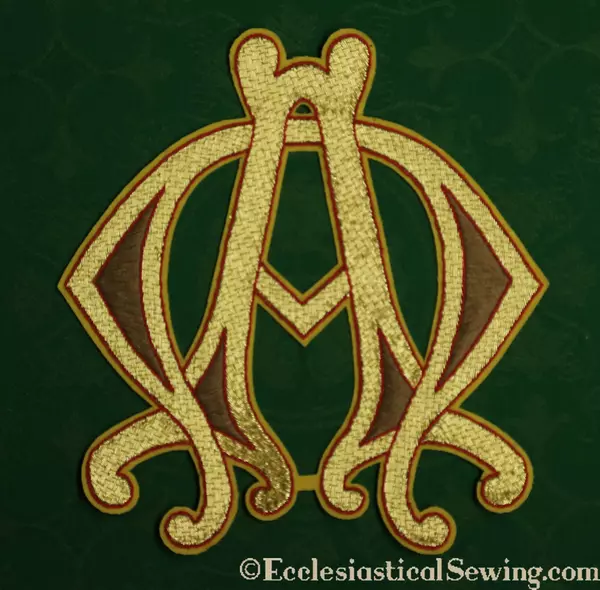Embroidered Appliques: How to Apply Goldwork Pieces
Designing a set of church vestments is a challenging endeavor. There are so many things to consider. When a decision is made on a set there is a sense of relief because it is time to get on with the fun of creating a project. Embroidered Appliques: How to Apply Goldwork Pieces
Goldwork Appliques Project
We currently have a beautiful project in the works at our Ecclesiastical Sewing Studios. It is an altar hanging set with a pulpit and lectern fall and a superfrontal for an altar. The set will be for a traditional church and their desire is to use elegant goldwork appliques.
Alpha and Omega – beginning and end. This is one of the symbols selected for use on the vestment set. It is a large applique made with goldwork threads and embroidery threads mounted on a stiff backing. The reflection of the gold threads makes it difficult to capture the image in photos. Yet that is a desirable effect with the finished vestment. The applique has a narrow edge that is very useful when it comes to mounting. This narrow edge is designed to help hold the design in position and as an aid to use when couching the design in place. Although the narrow edge is fairly consistent in size/width, there may be a few places where it is a bit wider than the trim which will be used to couch in place.
Appliques Artistry
To use these appliques, the ground fabric is stretched and pinned into place on a frame that has a piece of calico (or muslin). Using the motifs in the fabric, the Alpha Omega design is centered on the fabric. This might take a few tries to align things perfectly. Locate the desired position on the fabric. Centering on a design line helps.
.There is a narrow fabric edge that extends from the embroidered emblem. Before placing the emblem on the fabric, the edge was evened up and trimmed in a few places so that it would be wider than the gold threads that will be used to couch and hold the design in place.
This edge is usually covered with gold couching threads as a way to have a neat finish. Before using the couching threads, the emblem is hand-tacked in place. Several gold threads will work for this. Japanese gold threads are nice options.
Japanese Gold Threads
The Japanese gold threads are available in 4 sizes with No. 13 being the largest of the threads and No. 8 being the smallest.
Japanese Gold Threads are also referred to as K1 to K4. K1 is the alternate name for No. 13. Goldwork couching is always done by using pairs of threads. The threads are placed side by side or two threads are placed parallel to each other. A stitch is taken over both threads to hold them in place. While that is the general idea for couching Goldwork threads, there are a few more details (the technical stuff to gain mastery) that can be saved for another day.
For this project, we selected a No. 3 gold gild twist as the thread to use for couching the appliqué in place.
Both goldwork threads would work well. The decision to use the twist is because it affords a bit more flexibility and ease in stitching when turning so many corners.
Goldwork Applique’ Techniques
To make this job a bit easier, muslin (or calico) has been stretched over a frame. Next, the brocade is centered and pinned in place over the muslin. The frame is tightened and the applique work is ready to go. Select a nice needle when doing hand-couching of goldwork threads – an embroidery or crewel needle sized between 9 to 12 is a nice starting point. Some of my favorite needles are John James needles made in England. Please check with your local needlework or quilting store for needles or they may be purchased on sites such as Amazon.
Suitable threads for couching include Au Ver A Soie 100/3 in a gold tone. I like the color #241. Krenik Japan threads also work well for couching.
Two pieces of the gild twist are used side by side and placed along the yellow edge of the applique. The needle comes up on the outer edge of the gold threads and goes down between the god threads and the applique. The needle goes in and is pulled toward the center of the applique. This snugs the threads close to the applique. Two threads cover the design fairly well. I may apply a third row of threads just to be certain all of the yellow extension is covered.
Goldwork appliques add love to the look of extensive hand embroidery in a way that is much faster to apply. It is also a great way to begin working with gold threads before jumping into larger goldwork projects.
Photos of the finished work will follow in a bit.
Soli Deo Gloria
Be sure to visit our online store front Ecclesiastical Sewing where you may shop for Liturgical Fabrics, altar linen fabrics, church vestment-making patterns, liturgical machine embroidery designs, church vestment trims and notions and so much more. You may also find us on Ecclesiastical Sewing on Facebook, Twitter, and Pinterest. Sign up for our mailing list at the bottom of the page on our online store front and receive a free copy of our Small Linens Booklet as our way of saying thank you for following along.
Iron on Cross Appliques
VDMA Machine Embroidery Design for Stoles
Gilt Twist Goldwork Threads for Hand Embroidery
Through the Needle’s Eye – EGA Traveling Exhibit
Imitation Japanese Goldwork Embroidery Threads
How to prepare fabric for Machine Embroidery
Goldwork Embroidery and Meandering Thoughts

